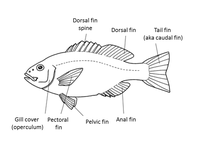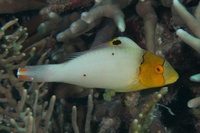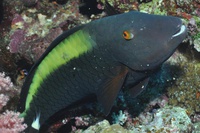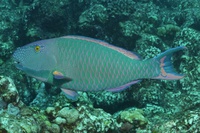Identifying fishes
Redmap Team.
So you caught a fish? Or spotted one you’ve never seen before? Or maybe you’re new to it all and don’t even know where to start…. Here are a few tips to get you started on identifying fishes...
Fish identification – where to start
Sure, some people can look at a fish and know immediately what it is…but for the rest of us, there are several ways to help you navigate this process and try to figure it out ourselves. It’s really about narrowing down options – firstly deciding whether it’s a bony fish (aka what you’d call a ‘normal or typical’ fish) or a cartilaginous fish (sharks or rays).
From here we group into Family… and one of the best ways to do this is to start with body shape. Once you start to become familiar with the types of overall body shape, you can start to narrow down your search area even quicker. There are a number of sites with identification keys or guides to help with this. The sites listed below use easy-to-follow PICTURES based on the shape of the fish:
· Fishes of Australia has this KEY
· FISHBASE has this identification GUIDE
A number of features are important in helping determine which species of fish you have. Often, it’s not a single feature, but the combination of a few that allow you to correctly identify a species – so keeping an eye out for as many as possible is important. Here’s a shortlist –it is certainly not comprehensive (often you need to count fin rays, look at eye size and positioning etc.), but it’s a good start:
BODY and HEAD SHAPE – this is generally the first factor relevant when determining a species. It can also tell you a lot about where the species lives and its behaviour. For example, a flattened fish body with eyes on the top of the head indicates the animal tends to live on the bottom.
FINS – like, ALL of them. We understand that when you’re diving you have about two seconds to grab a photo, and that fish aren’t great at posing… but for fishers or when you’ve got multiple photos to choose from – select ones with the fins clearly visible. Sometimes it’s not the position or shape of the fins, but their length RELATIVE to other fins that is important. Sometimes it’s the shape of the tail edge that matters (is it straight/convex/concave?). So try and make sure that all fins are visible – so a side-on photo with all of the fins showing is best.
LOCATION – sending in a fish with no information makes it hard. Location is needed to help narrow down the start point and sometimes to help decide which species it is. Be sure to check this in your reference books/sites (although we are on the look out for range-extenders...).
MARKINGS: spots/stripes etc. can be important. And although colour CAN be useful – it is often so variable that it’s not a deciding factor when identifying a fish – so probably not as useful as you might think. Fish can change colour within seconds, appear different when out of the water, with age, with gender, or with time of day (see images left for example of differences within one species). For many species, differences between juvenile and adult colouration are often so drastic that you might mistake them as different species. Many females and males are often strikingly different in colour and many fish exhibit what is called ‘night variation’ – where colours observed at night are different to that seen in the day.
Some tips from the experts:
- Always use multiple books or websites (to check and double-check)
- Ask for a second opinion (the world’s leading taxonomists [biologist that identifies and classifies animals/plants] do this ALL the time)
- Always check distribution information (it can be an important deciding factor)
Why can’t Redmap just identify everything you submit?
Redmap scientists all volunteer their time. So amongst field work, writing papers, chasing grants, doing presentations, teaching etc… they volunteer to help us identify your sightings - so it’s not part of their normal job. They do it because they see the value in citizen science and in tracking potentially range-extending species. So in part, the pre-defined Redmap species list is a way of making the workload manageable for volunteering scientists. We’ve provide information via our Redmap species pages that will help you decide whether you have a Redmap species – rather than something that’s common for your area. If you would like to learn more about your sightings of other species in your area, checkout the Australasian Fishes project on iNaturalist.
Species identification guides and relevant references:
http://www.fishesofaustralia.net.au/















